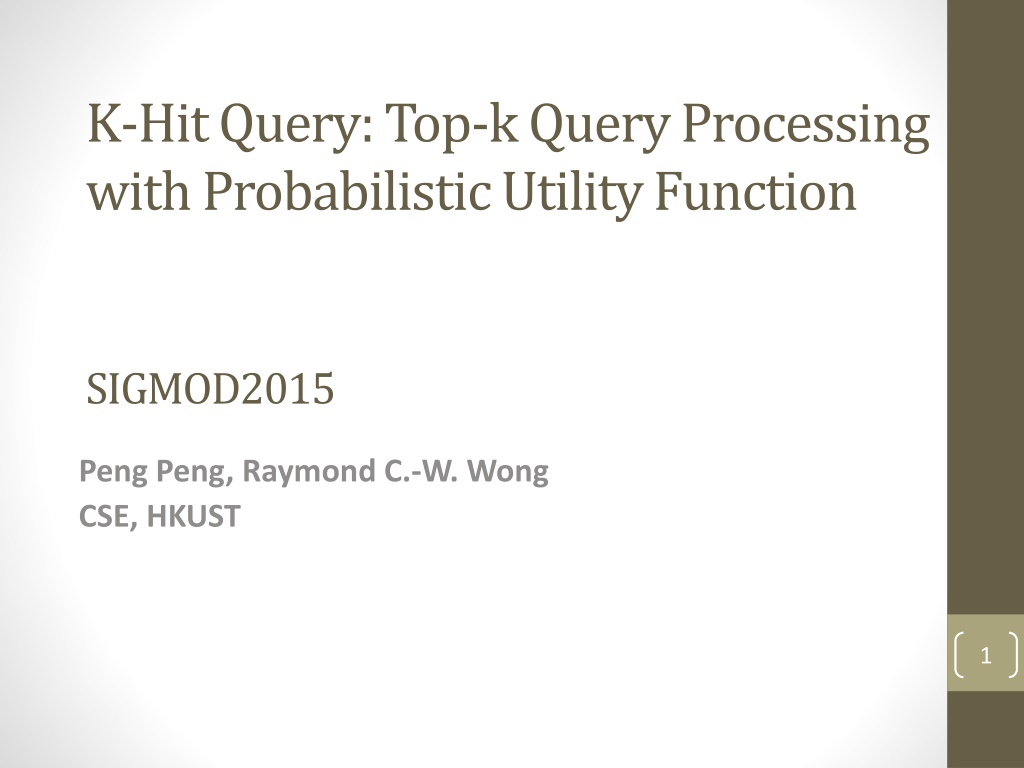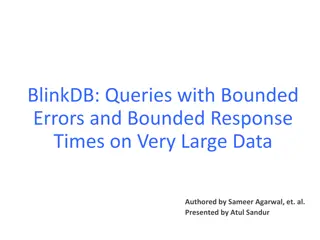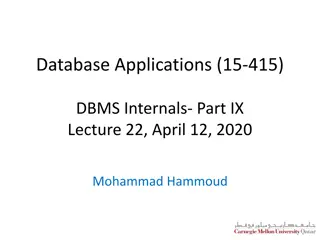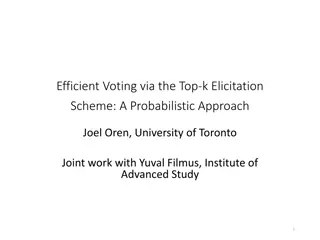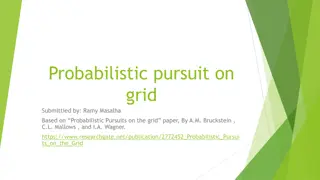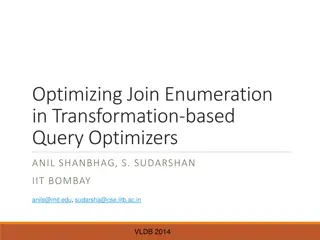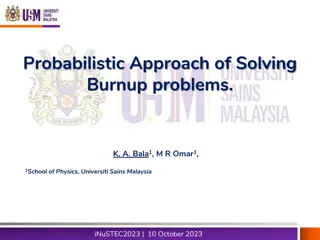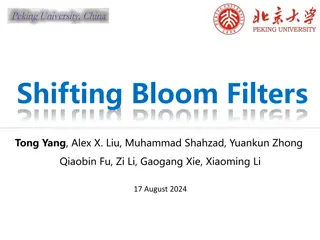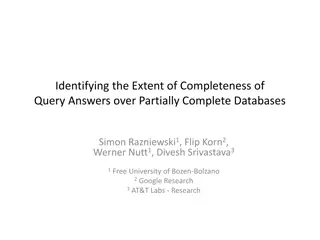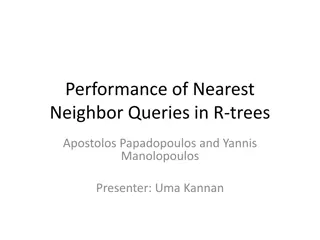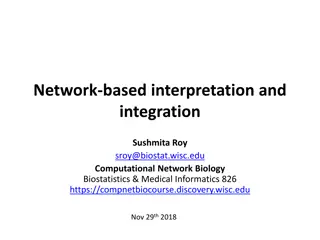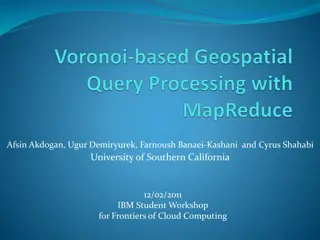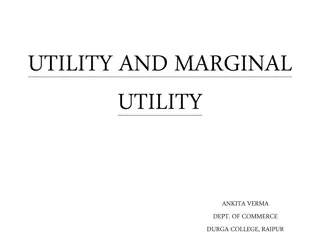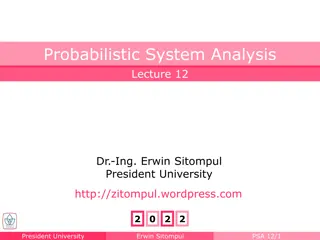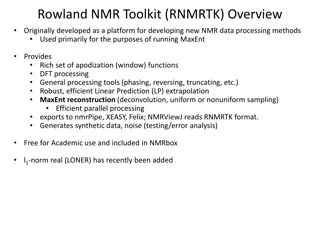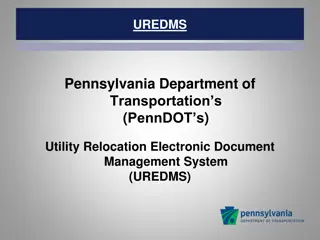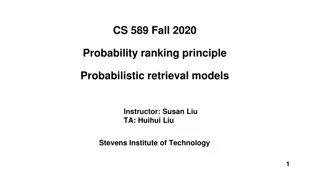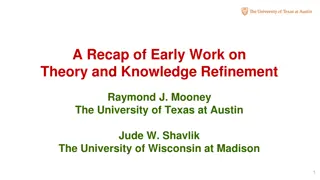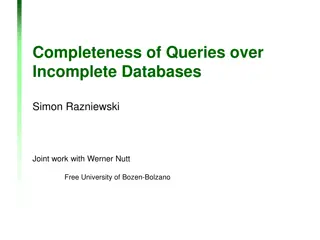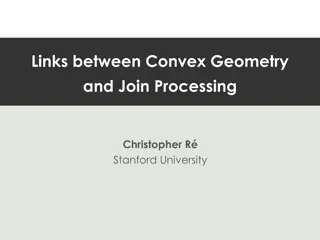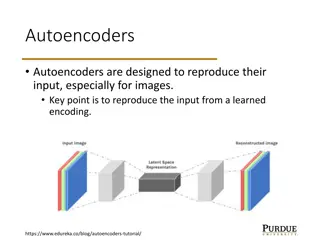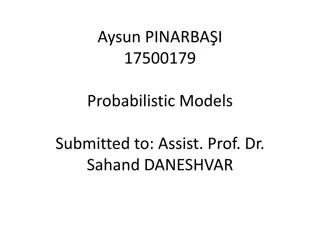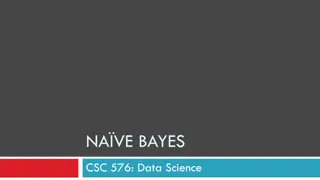Efficient Top-k Query Processing Using Probabilistic Utility Functions
This paper presents a method for determining which cars to display on an online car selling service based on users' utility functions. It explores the use of probabilistic utility functions to identify cars that users would be interested in, addressing limitations of traditional top-k and skyline queries. The distribution of users' utility functions can be obtained from user data, improving decision-making and user recommendations in various industries.
Download Presentation

Please find below an Image/Link to download the presentation.
The content on the website is provided AS IS for your information and personal use only. It may not be sold, licensed, or shared on other websites without obtaining consent from the author. Download presentation by click this link. If you encounter any issues during the download, it is possible that the publisher has removed the file from their server.
E N D
Presentation Transcript
K-Hit Query: Top-k Query Processing with Probabilistic Utility Function SIGMOD2015 Peng Peng, Raymond C.-W. Wong CSE, HKUST 1
Outline 1. Introduction 2. Contributions 3. Problem Definition 4. Algorithm k-Hit_Alg - Geometry Property 5. Experiment 6. Conclusion 2
1. Introduction An online car selling service place a car showroom in a prominent place of its webpage, where a very limited number of cars are shown. How can we determine which cars to be shown to the users? 3
1. Introduction We expect to show good cars to the users. Here, a "good" car means a car that a user would be interested in. In the literature, we are given a utility function for the user. With this utility function, existing studies could find the best car that this user is interested in. In this paper, we are given a distribution of users' utility functions (called probabilistic utility functions). 4
1. Introduction How to obtain the distribution? User log information Statistics from the users The distribution has been used by existing systems/models User s recommendation systems Bayesian Learning models User s preference elicitations The distribution on utility functions can be applied over not only a group of users but also a single user. This can help companies a lot for decision-making such as an effective promotion to a particular group of users. 5
1. Introduction Existing Approaches Top-k query Skyline query 6
1. Introduction Top-k queries and skyline queries have their own limitations. Top-k queries assume that the utility function of a single user is known. But, it is possible that the utility function of a single user is not known in some cases. Skyline queries may return too many outputs. 7
1. Introduction Top-k queries Top-k queries on certain databases with certain utility functions (ICDE12, TKDE07) Top-k queries on uncertain databases with certain utility functions (ICDE07, SIGMOD08) Top-k queries on certain databases with uncertain utility functions (our work) Other queries Skyline queries (ICDE01,SIGMOD06) K-Regret queries (VLDB10,SIGMOD12,ICDE14) Order-based skyline queries (SIGMOD10) 8
1. Introduction Most Closely Related Work Call to order: a hierarchical browsing approach to eliciting users preference (SIGMOD 2010) The paper proposed an order-based representative skyline problem. Consider the distribution of utility functions. Find a set of k tuples (e.g., ? cars) such that the similarity between the selection set and the whole dataset is maximized. The similarity between the selection set and the whole dataset is defined based on a number of parameters, namely ?, ? and ?. Disadvantages: It does not maximize the number of users who are interested in the selection set. The user parameters are not user-friendly. 9
2. Contributions We propose a novel k-hit query in the presence of the distribution of utility functions to maximize the number of users who are interested in the selection set. We propose algorithms using geometry properties for answering the k-hit query. 10
3. Problem Definition Each user is associated with a utility function ?. ? is the set of all possible utility functions. Probability Density Function For each ? ?, we define ? ? to denote the probability density function of ? based on the distribution . Intuitively, ?(?) corresponds to the proportion of users with utility function ?, where ? ?? ? ?? = 1. Standalone hit probability (??) of a point ? It is simply named as Hit Probability for Standalone Hit Probability . This corresponds to the proportion of users considering point ? as the "best" point. ?(?) is the set of all utility functions such that the corresponding users consider point p as the best point. Then, ?? ? = ? ?(?)? ? ??. 11
3. Problem Definition The hitting probability of a set ?: The probability that at least one point in ? is considered as the "best" point by a user. ?? ? = ? ??? ? . k-Hit Query (Problem Definition) Given a positive integer ?, we want to find a subset ? of ? containing ? tuples such that ??(?) is the greatest. 12
3. Problem Definition Different Settings: The form of a utility function Linear case Non-linear case The distribution of utility functions Uniform distribution Non-uniform distribution f = 2x[1] + 3x[2] + x[3] (with geometry properties) 13
4. Algorithm k-Hit_Alg- Geometry Property Let ????(?) be the convex hull constructed by the tuples in ? and their projections on the axis. Let ????(???? ? ) be the set of tuples on the surface of ????(?). ?5 ??1 ?1 ?4 ?2 ?3 ?6 14 ? ??2
4. Algorithm k-Hit_Alg- Geometry Property We use the concept of solid angle used in the computational geometry to compute the hitting probability of a point. Solid angle is a measure of how large the object appears to an observer looking from that point. 15
An Example in 2-d Convex Cone: An unbounded convex cone in a 2-dimensional space ????({?1,?2}). ?2denotes a 2-dimensional hypersphere ?1 ?2 ????({?1,?2}) ?2: 2-dimensional hypersphere ? 16
An Example in 2-d Solid Angle: Solid angle of a convex cone ? (denoted by ??(?)) is defined to be the volume of the convex cone ? (i.e., the red shadow area where ? = ????( ?1,?2)). ????({?1,?2}) ?1 ?2 ?2 ? =????(????( ?1,?2) ?2) ????(?2) 17 ?? ??,??
4. Algorithm k-Hit_Alg- Geometry Property We have just given a formal definition of the solid angle. Next, we will present our new concept called hitting solid angle , one component of our problem. After that, we will give the relationship between the solid angle and the hitting solid angle. 18
4. Algorithm k-Hit_Alg- Geometry Property Drawing a perpendicular vector, namely a hitting vector, from the origin ? to each facet of ????(?). There are 4 points on the surface of the convex hull in the example. The whole data space is divided into 4 partitions, each of which is the cone of a point on the surface of the convex hull. ???? ?? ?5 ?5 ?1 ???? ?? ?1 ???? ?? ?2 ?2 ???? ?? ?6 ?6 19 ? ?
4. Algorithm k-Hit_Alg- Geometry Property Hitting solid angle In the example, ????????? ?5 = {?1,?2}. We define the cone of ?5 to be ????( ?1,?2). Given a tuple ? ???? ???? ? , the hitting solid angle for ? is defined to be the solid angle of the cone ??of ?(i.e., ??(??)). ?5 ???? ?? ?5 ?1 ?1 ???? ?? ?1 ???? ?? ?2 ?2 ?2 ???? ?? ?6 20 ?6 ? ?
4. Algorithm k-Hit_Alg- Geometry Property When the solid angle of the cone ??of ? (i.e., the hitting solid angle for ?) is normalized, it is equal to the standalone hitting probability of ?. 1 2? ??(??) ?? ? = 21
4. Algorithm k-Hit_Alg- Geometry Property Two step framework (?-hit_Alg) Step 1 (Standalone ?? computation): For each tuple ? in ?, we compute the standalone hit probability of ? (i.e., ??(?)) based on the distribution. Computing HP is equivalent to computing the hitting solid angle. Step 2 (Output): We find a set ? of ? tuples in ? with the greatest standalone hit probabilities. Theorem The general framework of ?-hit_Alg returns the optimal solution of a ?-hit query. Standalone ?? computation 22
4. Algorithm k-Hit_Alg- Geometry Property Standalone ?? computation Computing solid angle is challenging! Instead, consider a sampling-based HP computation, which is applied for any distribution of utility functions. Theorem Given a confidence parameter ? [0,1] and an error parameter ? [0,1], if the sampling size N 1 ?) 2 ? 8?1?2(??2 ?? is at least 1 ?, , then with confidence ?2 ?? ? ?? ?? ? 23
4. Algorithm k-Hit_Alg- Geometry Property Sampling-based ?? computation in 5 steps Step 1 (Hyperplane Set Construction) Step 2 (Index Construction) Step 3 (Sample Random Vectors) Step 4 (Ray Shooting Query) Step 5 (Counting) 24
5. Experiment Datasets Household dataset (6d): n = 903077, d = 6 Household dataset (10d): n = 1103241, d = 10 NBA dataset: n = 21962, d = 5 Color dataset: n = 68040, d = 9 Stocks dataset: n = 122574, d = 5 25
Experiments on NBA dataset Effect of ? on Hit Probability/Query Time/Memory Usage For the NBA dataset, k-hit_Alg gives the greatest hitting probability with a reasonable query time (within 1 second), using memory of a reasonable size (within 400 KB). 26
6. Conclusion We proposed a k-hit query, which returns a set of k tuples such that the probability that one of the k tuples is considered as the best tuple by a user is maximized. We proposed an algorithm called k-hit_Alg for answering the k-hit query. 27
ANY QUESTIONS? THANK YOU! 28
